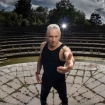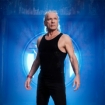"We don't look over our shoulders," says Iron Maiden founder/bassist Steve Harris, when asked if any songs from his band's 27-year history cause him to cringe. "Sure, some tracks are not as good as others, but we've written some really strong, classic stuff, like 'The Number of the Beast,' 'Hallowed Be Thy Name,' and 'Rime of the Ancient Mariner.'"
Since the band emerged with its 1979 Soundhouse Tapes demo, Iron Maiden's influence on heavy metal has been immeasurable. The group's twin- (now triple-) guitar attack, operatic vocals, literate lyrical themes, theatrical stage sets, and eye-popping album art (their zombie-like mascot, "Eddie the Head," is a ubiquitous symbol among leagues of heshers, and more recently, hipsters) helped define the New Wave of British Heavy Metal and continue to inspire fans and artists worldwide—verily, everyone from Metallica to Avenged Sevenfold owe a debt to Maiden.
In the midst of an American tour supporting A Matter of Life and Death (Sanctuary), the band's 14th full-length studio release, Harris was kind enough to share with us his thoughts on the eight classic Iron Maiden albums that secured this legendary act's place in the heavy-metal pantheon.
Iron Maiden
(Capitol, 1980)
Thanks to Harris, vocalist Paul Di'Anno, guitarists Dave Murray and Dennis Stratton, and drummer Clive Burr's constant touring, high-energy performances, and stellar three-song Soundhouse Tapes demo, by 1979 Iron Maiden's popularity had culminated in a sold-out show at London's Marquee Club, where the band was signed by EMI execs who reportedly couldn't even push their way into the crowded venue. Soon after, Iron Maiden entered London's Kingsway Studios, tracked nine songs, and emerged with one of heavy metal's strongest debuts.
"For the four years before the album, we had been extensively touring the U.K., playing clubs and pubs," recalls Harris. "We built up a hardcore following, but we were really still semipro, gigging over long weekends and the like. So after EMI signed us, we packed in the day jobs because we had to make an album. It was a weird, worrisome time, because you're thinking, We're putting all our time and effort into this…what if it doesn't work out? All we were hoping to do was to get a deal, make an album, and tour the U.K. We didn't really look toward the rest of the world. But when the album came out, things kinda took off…big time. [Laughs] At the end of 1980, we went on a European tour with Kiss. It was a fantastic experience."
Killers
(Capitol, 1981)
In late 1980, guitarist Adrian Smith replaced Dennis Stratton, and the band soon hit the studio with producer Martin Birch, whose impressive credits included work with Black Sabbath, Deep Purple, and Rainbow.
"We wanted Adrian from the start, but he wasn't ready to leave his band Urchin. So it was great when he finally joined, because we got the man we always wanted. Most of the stuff from the first two albums was written before we were signed. There were only a few completely new songs, such as 'Murders in the Rue Morgue,' 'Killers,' 'Prodigal Son,' and 'Twilight Zone.' All the rest of the songs had been the mainstay of our set for years, so there wasn't much pressure with the material. But meeting Martin Birch for the first time was kind of nervy, because he was this big, respected producer. But, obviously, we got on great with him, because it turned into a fantastic working relationship that lasted many years.
"This was also when we started to have problems with Paul. We'd get out on tour for a couple months, and he'd start complaining about everything. We all liked Paul—we still like him now as a person—but he just didn't want to be there. He had this self-destruct button, and we knew if we carried on with him, he would take us under. So, unfortunately, we had to do something about it." [Di'Anno, who was addicted to alcohol at the time, was asked to leave in 1981.]
The Number of the Beast
(Capitol, 1982)
A pivotal point in Maiden's career, their third album featured former Samson frontman Bruce Dickinson as their new singer. The Number of the Beast broadened Maiden's popularity—and notoriety, as "decency advocates" in the U.S. denounced the band for the title track's supposed satanic implications.
"It was fate that Bruce came in. He was so fantastic, and he could hit notes and do things most other singers couldn't. But at the time, it was pretty scary! [Laughs] We were already headlining most countries, and it was scary changing a singer because we didn't know if people were gonna like it or not. The Number of the Beast was a lot of pressure, but sometimes, pressure brings out the best in you. And it did. It paid off big time.
"The negative reactions to 'The Number of the Beast' were strange. When we wrote it, we never expected anything like that. It was funny at first—we thought everyone was just being crazy. But then we realized people were serious about it, and we were like, 'Oh, dear…'" [Laughs]
Piece of Mind
(Capitol, 1983)
Drummer Nicko McBrain replaces Burr, creating what many consider the quintessential Maiden lineup. After taking over the restaurant in the Le Chalet Hotel on the Channel Island of Guernsey, England, to write and rehearse, the band headed south to Compass Point Studios in the Bahamas to make Piece of Mind.
"Recording at Compass Point was really fantastic. When you're in the studio, you could be anywhere: It could be snowing outside or whatever. But it's great fun when you come out of the studio and are greeted by nice weather and good bars. And no disrespect to Clive—because he's really good—but Nicko is a fantastic technical drummer, and his presence just naturally took Maiden's music to another level. It was really exciting. We also had a bit of fun in response to 'The Number of the Beast' backlash by recording backwards messages of Nicko doing stupid voices. We were just having fun, but people actually took it seriously!" [Laughs]
Powerslave
(Capitol, 1984)
Powerslave contained the epic "Rime of the Ancient Mariner," as well as Maiden classics "2 Minutes to Midnight" and "Aces High," which the burgeoning MTV Network introduced into its rotation. Powerslave's accompanying World Slavery tour was highlighted by Maiden's show in Poland, which marked the first time a band had taken a full arena production behind the Iron Curtain.
"'Rime of the Ancient Mariner' was completely written in my little one-bedroom apartment at Compass Point Studios. It just came out. I don't know why these things come out. I don't analyze why they do, in case they don't. [Laughs] It was a whole new era around this time. For our World Slavery tour, we were playing huge shows in places like Poland, where no other big band had been. We were breaking new ground, and it was great that the audiences appreciated it so much. It was very endearing, so we just gave them everything."
Live After Death
(Capitol, 1985)
On the World Slavery tour, the band decided to roll tape during its four-night run at the Long Beach Arena in California. The resulting album captured Maiden in top form as they burned through their hits.
"Obviously, there was a lot of pressure those nights, because we were recording live. It was pretty scary. [Laughs] You try and forget about it and put it out of your mind, but when there are cameras in front of your face, it's not easy. You try and just steam through. We only recorded two of the four L.A. shows. Actually, I don't know why we didn't record all the nights! [Laughs] We used something like two songs from one night and the rest from the other. I remember feeling we had played well. But you don't really know until afterward. The cold light of day sometimes tells a different story. [Laughs] But when we listened back to it, we were like, Oh, yeah this is really good."
Somewhere in Time
(Capitol, 1986)
On the heals of the successful Powerslave/Live After Death releases, Maiden charted a different course with Somewhere in Time, by introducing guitar and bass synthesizers into their mix.
"We wanted to make things more orchestral. Actually, thinking about it now, if the technology had been around before, we would have used synths earlier. We've always been into trying new things. We like to go with the flow, and it really felt right adding synths to Somewhere in Time. I think it really suits the music, and we've used keys or guitar synths ever since."
Seventh Son of a Seventh Son
(EMI International, 1988)
An elaborate concept record about the life of a prophet, Seventh Son of a Seventh Son, marked the end of a classic era, as it was the last Maiden album Smith would play on for over 10 years.
"The concept for Seventh Son just unfolded naturally. We wrote two or three songs in that vein, when Bruce asked, 'Why don't we do a concept album?' We were like, 'Yeah, why not?' It was a great challenge, lyrically, to sink our teeth into. I think you need new challenges all the time. For a couple of tours before Seventh Son, Adrian had been unhappy. Actually, we had talked to him after Somewhere in Time, but it really came around again on the Seventh tour. Basically, I think he just wanted to do solo stuff, so we parted ways. It's just one of those fated things, because he's back in the band now, which is great. I guess sometimes people have to go away from something to realize what they missed. We also missed him, as well, but I think it's worse when you're on the outside."












